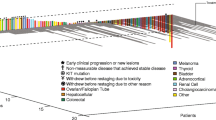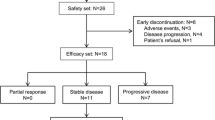Abstract
The use of vascular endothelial growth factor (VEGF)-targeted agents for treating cancer has increased dramatically over recent decades. These drugs provide considerable benefits in terms of progression-free (PFS) or overall (OS) survival for cancer patients. Of particular importance to clinicians treating cancer patients by using VEGF-targeted agents is VEGF-inhibition-induced hypertension, proteinuria, thrombosis and hemorrhage. Aflibercept is a new, successful example of targeting VEGF for therapy of solid tumors. Though results from phase I and II clinical trials demonstrated aflibercept is well tolerated, it inevitably has severe adverse effects unique to this class of agents. In this review, we discuss the adverse effects associated with aflibercept (VEGF Trap), focusing on vascularassociated hypertension, proteinuria, hemorrhage, and thrombosis, and further discuss the mechanisms, significance, and potential management of these adverse effects.
Similar content being viewed by others
References
Wulff C, Wilson H, Wiegand SJ et al (2002) Prevention of thecal angiogenesis, antral follicular growth, and ovulation in the primate by treatment with vascular endothelial growth factor Trap R1R2. Endocrinol 143:2797–2807
Kim ES, Serur A, Huang J et al (2002) Potent VEGF blockade causes regression of coopted vessels in a model of neuroblastoma. Proc Natl Acad Sci USA 99:11399–11404
Holash J, Davis S, Papadopoulos N et al (2002) VEGF-Trap: a VEGF blocker with potent antitumor effects. Proc Natl Acad Sci USA 99:11393–11398
Huang J, Frischer JS, Serur A et al (2003) Regression of established tumors and metastases by potent vascular endothelial growth factor blockade. Proc Natl Acad Sci USA 100:7785–7790
Fukasawa M, Korc M (2004) Vascular endothelial growth factor-trap suppresses tumorigenicity of multiple pancreatic cancer cell lines. Clin Cancer Res 10:3327–3332
Kadenhe-Chiweshe A, Papa J, McCrudden KW et al (2008) Sustained VEGF blockade results in microenvironmental sequestration of VEGF by tumors and persistent VEGF receptor-2 activation. Mol Cancer Res 6:1–9
Frischer JS, Huang J, Serur A et al (2004) Effects of potent VEGF blockade on experimental Wilms tumor and its persisting vasculature. Int J Oncol 25:549–553
Huang J, Frischer JS, New T et al (2004) TNP-470 promotes initial vascular sprouting in xenograft tumors. Mol Cancer Ther 3:335–343
Byrne AT, Ross L, Holash J et al (2003) Vascular endothelial growth factor-trap decreases tumor burden, inhibits ascites, and causes dramatic vascular remodeling in an ovarian cancer model. Clin Cancer Res 9:5721–5728
Inai T, Mancuso M, Hashizume H et al (2004) Inhibition of vascular endothelial growth factor (VEGF) signaling in cancer causes loss of endothelial fenestrations, regression of tumor vessels, and appearance of basement membrane ghosts. Am J Pathol 165:35–52
Baffert F, Le T, Sennino B et al (2006) Cellular changes in normal blood capillaries undergoing regression after inhibition of VEGF signaling. Am J Physiol Heart Circ Physiol 290:H547–559
Le XF, Mao W, Lu C et al (2008) Specific blockade of VEGF and HER2 pathways results in greater growth inhibition of breast cancer xenografts that overexpress HER2. Cell Cycle 7:3747–3758
Lu H, Klein RS, Schwartz EL (2009) Antiangiogenic and antitumor activity of 6-(2-aminoethyl) amino-5-chlorouracil, a novel small-molecule inhibitor of thymidine phosphorylase, in combination with the vascular endothelial growth factortrap. Clin Cancer Res 15:5136–5144
Gomez-Manzano C, Holash J, Fueyo J et al (2008) VEGF Trap induces antiglioma effect at different stages of disease. Neuro Oncol 10:940–945
Dalal S, Berry AM, Cullinane CJ et al (2005) Vascular endothelial growth factor: a therapeutic target for tumors of the Ewing’s sarcoma family. Clin Cancer Res 11:2364–2378
Verheul HM, Hammers H, van Erp K et al (2007) Vascular endothelial growth factor trap blocks tumor growth, metastasis formation, and vascular leakage in an orthotopic murine renal cell cancer model. Clin Cancer Res 13:4201–4208
Hu L, Hofmann J, Holash J et al (2005) Vascular endothelial growth factor trap combined with paclitaxel strikingly inhibits tumor and ascites, prolonging survival in a human ovarian cancer model. Clin Cancer Res 11:6966–6971
Wachsberger PR, Burd R, Cardi C et al (2007) VEGF trap in combination with radiotherapy improves tumor control in U87 glioblastoma. Int J Radiat Oncol Biol Phys 67:1526–1537
Lockhart AC, Rothenberg ML, Dupont J et al (2010) Phase I study of intravenous vascular endothelial growth factor trap, aflibercept, in patients with advanced solid tumors. J Clin Oncol 28:207–214
Mulay M, Limentani SA, Carroll M et al (2006) Safety and pharmacokinetics of intravenous VEGF Trap plus FOLFOX4 in a combination phase I clinical trial of patients with advanced solid tumors. J Clin Oncol 24:abstr 13061
Limentani S, Just R, Purdham A et al (2008) A phase I dose escalation and pharmacokinetic (PK) study of intravenous (iv) aflibercept (VEGF Trap) plus FOLFOX4 in patients (pts) with advanced solid tumors: Preliminary results. J Clin Oncol 26:abstr 3556
Rixe O, Verslype C, Méric JB et al (2006) Safety and pharmacokinetics of intravenous VEGF Trap plus irinotecan, 5-fluorouracil, and leucovorin (I-LV5FU2) in a combination phase I clinical trial of patients with advanced solid tumors. J Clin Oncol 24:abstr 13161
Verslype C, Spano J, Van Cutsem E et al (2008) Validation of the selected dose of aflibercept (VEGF Trap) plus irinotecan, 5-fluorouracil, and leucovorin (I-LV5FU2) in a phase I clinical trial of patients (pts) with advanced solid tumors (STs): Preliminary results. J Clin Oncol 26:abstr 14540
Rixe O, Verslype C, Khayat D et al (2008) A phase I dose escalation (DE) and pharmacokinetics (PK) study of intravenous aflibercept (VEGF Trap) plus irinotecan, 5-fluorouracil, and leucovorin (I-LV5FU2) in patients with advanced solid tumors (STs). J Clin Oncol 26:abstr 3557
Isambert N, Freyer G, Zanetta S et al (2008) A phase I dose escalation and pharmacokinetic (PK) study of intravenous aflibercept (VEGF trap) plus docetaxel (D) in patients (pts) with advanced solid tumors: Preliminary results. J Clin Oncol 26:abstr 3599
Freyer Sr G, Fumoleau P, You B et al (2008) A phase I dose escalation and pharmacokinetic (PK) study of intravenous (iv) aflibercept (VEGF Trap) plus docetaxel (D) and cisplatin (C) in patients (pts) with advanced solid tumors: preliminary results. J Clin Oncol 26:abstr 14539
Patnaik A, Pipas M, Rosen LS et al (2008) A phase I dose escalation and pharmacokinetic (PK) study of intravenous (iv) aflibercept (VEGF Trap) plus weekly gemcitabine (Gem) in patients (pts) with advanced solid tumors: preliminary results. J Clin Oncol 26:abstr 3558
Tew WP, Colombo N, Ray-Coquard I et al (2007) VEGF-Trap for patients (pts) with recurrent platinum-resistant epithelial ovarian cancer (EOC): Preliminary results of a randomized, multicenter phase II study. J Clin Oncol 25:abstr 5508
Colombo N, Mangili G, Mammoliti S et al (2008) Aflibercept (VEGF Trap) for advanced epithelial ovarian cancer (EOC) patients (pts) with symptomatic malignant ascites: Preliminary results of a pilot study. J Clin Oncol 26:abstr 14598
Tang P, Cohen SJ, Bjarnason GA et al (2008) Phase II trial of aflibercept (VEGF Trap) in previously treated patients with metastatic colorectal cancer (MCRC): A PMH phase II consortium trial. J Clin Oncol 26:abstr 4027.
Massarelli E, Miller VA, Leighl NB et al (2007) Phase II study of the efficacy and safety of intravenous (IV) AVE0005 (VEGF Trap) given every 2 weeks in patients (Pts) with platinum- and erlotinib-resistant adenocarcinoma of the lung (NSCLA). J Clin Oncol 25:abstr 7627.
Townsley C, Hirte H, Hoskins P et al (2009) A phase II study of aflibercept (VEGF trap) in recurrent or metastatic gynecologic soft-tissue sarcomas: A study of the Princess Margaret Hospital Phase II Consortium. J Clin Oncol 27:abstr 5591
Twardowski P, Stadler WM, Frankel P et al (2009) Phase II study of aflibercept (VEGF-Trap) in patients (pts) with recurrent or metastatic transitional cell carcinoma (TCC) of the urothelium: A California Cancer Consortium trial. J Clin Oncol 27:abstr e16030
Tarhini AA, Christensen S, Frankel P et al (2009) Phase II study of aflibercept (VEGF trap) in recurrent inoperable stage III or stage IV melanoma of cutaneous or ocular origin. J Clin Oncol 27:abstr 9028
De Groot JF, Wen PY, Lamborn K et al (2008) Phase II single arm trial of aflibercept in patients with recurrent temozolomide-resistant glioblastoma: NABTC 0601. J Clin Oncol 26:abstr 2020
Tew WP, Gordon M, Murren J et al Phase 1 study of aflibercept administered subcutaneously to patients with advanced solid tumors. Clin Cancer Res 2010; 16:358–366
Dupont J, Schwartz L, Koutcher J et al (2004) Phase I and pharmacokinetic study of VEGF Trap administered subcutaneously (sc) to patients (pts) with advanced solid malignancies. J Clin Oncol 22:abstr 3009
Coleman RL, Kamat A, Iyer R et al (2009) Phase I and pharmacokinetic study of the novel VEGF-directed fusion protein, aflibercept, in combination with docetaxel in women with recurrent ovarian, fallopian tube, and primary peritoneal cancer. J Clin Oncol 27:abstr 5549
Dupont J, Rothenberg ML, Spriggs DR et al (2005) Safety and pharmacokinetics of intravenous VEGF Trap in a phase I clinical trial of patients with advanced solid tumors. J Clin Oncol 23:abstr 3029
Zhu X, Wu S, Dahut WL, Parikh CR (2007) Risks of proteinuria and hypertension with bevacizumab, an antibody against vascular endothelial growth factor: systematic review and meta-analysis. Am J Kidney Dis 49:186–193
Horowitz JR, Rivard A, van der Zee R et al (1997) Vascular endothelial growth factor/vascular permeability factor produces nitric oxide-dependent hypotension. Evidence for a maintenance role in quiescent adult endothelium. Arterioscler Thromb Vasc Biol 17:2793–2800
Hood JD, Meininger CJ, Ziche M, Granger HJ (1998) VEGF upregulates ecNOS message, protein, and NO production in human endothelial cells. Am J Physiol 274:H1054–1058
Chobanian AV, Bakris GL, Black HR et al (2003) The Seventh Report of the Joint National Committee on Prevention, Detection, Evaluation, and Treatment of High Blood Pressure: the JNC 7 report. JAMA 289:2560–2572
Kanellis J, Levidiotis V, Khong T et al (2004) A study of VEGF and its receptors in two rat models of proteinuria. Nephron Physiol 96:P26–36
Eremina V, Sood M, Haigh J et al (2003) Glomerular-specific alterations of VEGF-A expression lead to distinct congenital and acquired renal diseases. J Clin Invest 111:707–716
Schrijvers BF, Flyvbjerg A, De Vriese AS (2004) The role of vascular endothelial growth factor (VEGF) in renal pathophysiology. Kidney Int 65:2003–2017
Kamba T, Tam BY, Hashizume H et al (2006) VEGF-dependent plasticity of fenestrated capillaries in the normal adult microvasculature. Am J Physiol Heart Circ Physiol 290:H560–576
Izzedine H, Massard C, Spano JP et al (2010) VEGF signalling inhibition-induced proteinuria: Mechanisms, significance and management. Eur J Cancer 46:439–448
Maynard SE, Min JY, Merchan J et al (2003) Excess placental soluble fms-like tyrosine kinase 1 (sFlt1) may contribute to endothelial dysfunction, hypertension, and proteinuria in preeclampsia. J Clin Invest 111:649–658
Sugimoto H, Hamano Y, Charytan D et al (2003) Neutralization of circulating vascular endothelial growth factor (VEGF) by anti-VEGF antibodies and soluble VEGF receptor 1 (sFlt-1) induces proteinuria. J Biol Chem 278:12605–12608
Gerber HP, Wu X, Yu L et al (2007) Mice expressing a humanized form of VEGF-A may provide insights into the safety and efficacy of anti-VEGF antibodies. Proc Natl Acad Sci USA 104:3478–3483
Kilickap S, Abali H, Celik I (2003) Bevacizumab, bleeding, thrombosis, and warfarin. J Clin Oncol 21:3542
Zachary I (2001) Signaling mechanisms mediating vascular protective actions of vascular endothelial growth factor. Am J Physiol Cell Physiol 280:C1375–1386
Spivak JL (2002) Polycythemia vera: myths, mechanisms, and management. Blood 100:4272–4290
Tam BY, Wei K, Rudge JS et al (2006) VEGF modulates erythropoiesis through regulation of adult hepatic erythropoietin synthesis. Nat Med 12:793–800
Regeneron: Afibercept (VEGF Trap) (2010) http://www.regeneron.com/vegftrap_cancer.html. Accessed on 01 May 2010
Author information
Authors and Affiliations
Corresponding author
Rights and permissions
About this article
Cite this article
Jin, K., Shen, Y., He, K. et al. Aflibercept (VEGF Trap): one more double-edged sword of anti-VEGF therapy for cancer?. Clin Transl Oncol 12, 526–532 (2010). https://doi.org/10.1007/s12094-010-0550-4
Received:
Accepted:
Published:
Issue Date:
DOI: https://doi.org/10.1007/s12094-010-0550-4




